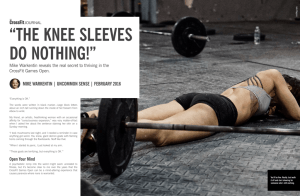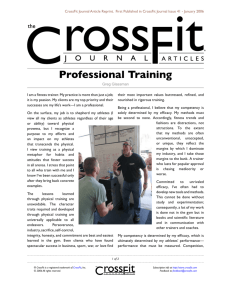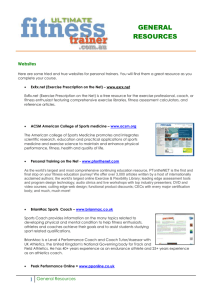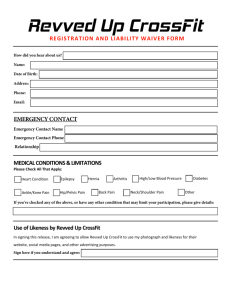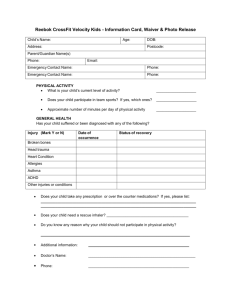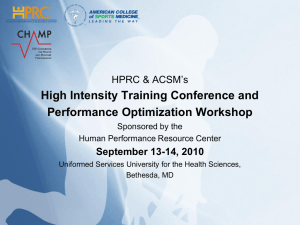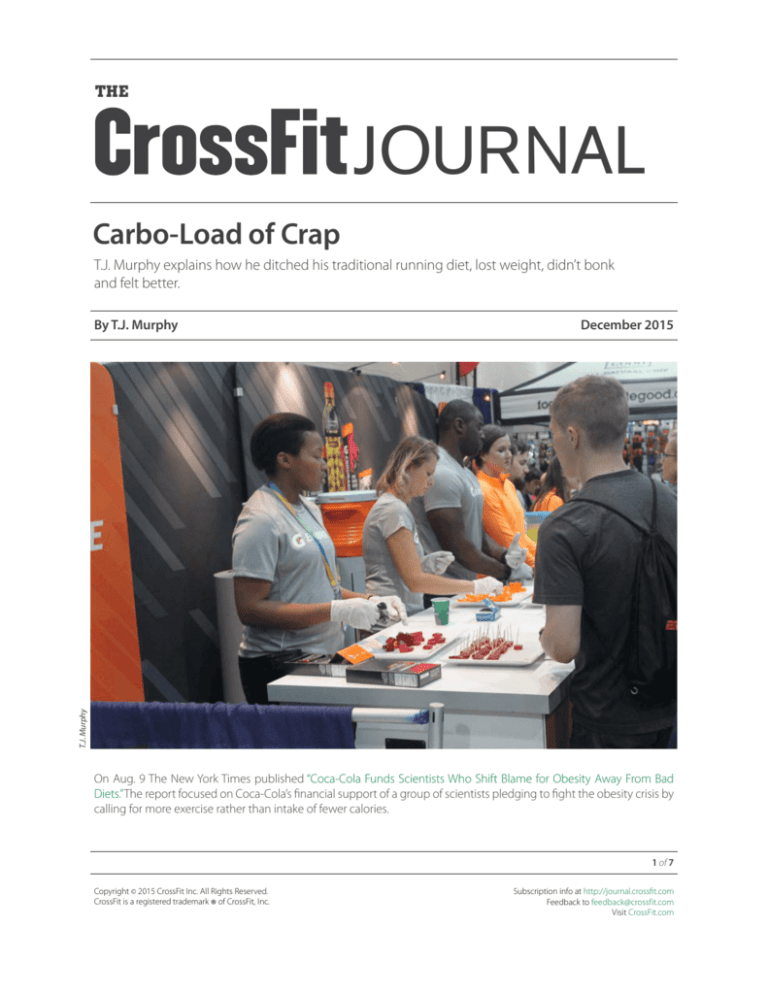
THE
JOURNAL
Carbo-Load of Crap
T.J. Murphy explains how he ditched his traditional running diet, lost weight, didn’t bonk
and felt better.
December 2015
T.J. Murphy
By T.J. Murphy
On Aug. 9 The New York Times published “Coca-Cola Funds Scientists Who Shift Blame for Obesity Away From Bad
Diets.” The report focused on Coca-Cola’s financial support of a group of scientists pledging to fight the obesity crisis by
calling for more exercise rather than intake of fewer calories.
1 of 7
Copyright © 2015 CrossFit Inc. All Rights Reserved.
CrossFit is a registered trademark of CrossFit, Inc.
®
Subscription info at http://journal.crossfit.com
Feedback to feedback@crossfit.com
Visit CrossFit.com
Carbo-Load ...
(continued)
“Coke has provided financial and logistical support to
a new nonprofit organization called the Global Energy
Balance Network, which promotes the argument that
weight-conscious Americans are overly fixated on how
much they eat and drink while not paying enough
attention to exercise,” according to the Times.
The article created a backlash that set Coca-Cola in full
retreat, and chairman and CEO Muhtar Kent wrote a Wall
Street Journal op-ed piece that stated the company would
be more transparent about its funding of research. Kent’s
piece created an additional wave of criticism.
Although PepsiCo, McDonald’s, Kraft Foods and Hershey’s
were also mentioned in the original New York Times
piece as companies who sponsor food-industry research,
Gatorade—owned by PepsiCo—did not appear in the
article. Interestingly, Gatorade has offered financial support
to exercise scientists conducting studies on hydration and
carbohydrate intake for decades.
“We have a half-marathon in Cape Town, and we did a
study on the field. We found that 30 percent of the runners
in the field were insulin resistant and obese,” Noakes said.
Also alarming for Noakes was that the runners weren’t
doing themselves any favors in the race.
“They were literally eating tons of sugar during the race,” he
said in the podcast.
In a November 2014 Australian Broadcast Corporation
interview, Noakes talked about his role in the overconsumption of sugar.
“I spent 33 years of my life telling athletes that they must
carbohydrate load, which meant that for the last three
days before a marathon, you should eat 700 or 800g of
carbohydrate (per day). And I was the first in the world to
produce these GUs that people lived their races on. So if
T.J. Murphy
Dr. Tim Noakes, best known in some circles for his research
on hydration, is one of those who has in recent years
publicly reversed his position and openly attacked soft-drink
companies for their support of high-carbohydrate diets. In
a January 2015 Primal Blueprint podcast, Noakes blamed
high-carb diets for race fields crowded with “fat runners” at
recent marathons.
Dr. Tim Noakes said he regrets his role in developing early
versions of the high-carb supplements that now fuel the
endurance community.
you go to the Ironman, you’ll see people taking GUs every
half hour or so. So myself and Bruce Fordyce, who’s the
great South African ultramarathon runner, developed that
product and I apologize because that was completely
wrong,” he said.
“GUs” are small packages of semi-solid energy paste, some
with caffeine, that an endurance athlete can consume for
an approximately 100-calorie infusion of carbohydrate.
Noakes was referring specifically to Leppin FRN Squeezies,
which he helped develop in the early 1980s. “FRN” was an
initialism representing the inventors: F for Fordyce, and R
for Bernard Rose, a South African 2:10 marathoner.
The N stood for Noakes.
Running in the Wrong Direction
“For 30 years I was part of the problem,” Noakes told me in
a Skype call from his office in Cape Town, South Africa, in
April 2015.
2 of 7
Copyright © 2015 CrossFit Inc. All Rights Reserved.
CrossFit is a registered trademark of CrossFit, Inc.
®
Subscription info at http://journal.crossfit.com
Feedback to feedback@crossfit.com
Visit CrossFit.com
Carbo-Load ...
(continued)
laboratory—Ball State University—was conducted in 1970,
with resulting article “Fluid Ingestion During Distance
Running” published in Archives of Environmental Health:
An International Journal. The study’s lead author, David
Costill, had asked Gatorade for US$800. The company gave
him $8,000, and a symbiotic relationship between sports
science and the beverage industry was born.
“We did research on carbs because that’s what we could
afford to do,” Noakes told me.
Courtesy of Dr. Tim Noakes
He was earnest about his overall conclusion that a
high-carbohydrate diet was essential to running well.
Throughout the 1980s and into the 1990s, Noakes either
led or contributed to studies on sugar for endurance
athletes, such as “Carbohydrate Ingestion and Muscle
Glycogen Depletion During Marathon and Ultramarathon
Racing,” published in the European Journal of Applied
Physiology in 1988.
“Based on the data and evidence we had, it seemed clear
that carbohydrates were the key to performance. The
evidence was so convincing,” Noakes said.
“We did research on carbs because that’s what we could
afford to do.” —Dr. Tim Noakes
Noakes was talking about the overall trend of sportsscience research directed at endurance athletes and
carbohydrate. The trend started in the 1960s with the
invention of Gatorade and continues today: At an
American College of Sports Medicine conference in San
Diego, California, this past spring, I sat through several
hours of lectures stating a high rate of carbohydrate
intake is crucial to athletic performance.
“For 30 years I was part of
the problem.”
—Dr. Tim Noakes
In 1969, Noakes, who had a passion for distance running,
graduated from the University of Cape Town medical
school and set out to be a sports scientist. Coincidentally,
the first Gatorade-funded study at an independent
In 1981, due to Noakes’ influence, the Comrades
Marathon—an “ultramarathon”—posted aid stations after
every one of the race’s 56 miles. In 1985, Noakes published
the first edition of what has long been considered the
bible of sports science for distance runners: “The Lore of
Running.” The book contains hundreds of pages detailing
the prevailing research on the physiology and biochemistry
of running, with a huge emphasis on how “many exercise
scientists around the world have become convinced that
the ingestion of a high-carbohydrate diet is the secret to
optimum performance during prolonged exercise.”
Noakes reversed his position on the high-carbohydrate
diet in early 2011. Even though he was a runner and didn’t
drink or smoke, Noakes—in his early 60s at the time—
was overweight and diagnosed with Type 2 diabetes.
Desperate for an answer, he tried a low-carb diet he had
read about in an ad on the Internet. The promise was that
he would lose 11 lb. in as few as eight weeks.
“In eight weeks I lost 11 kilograms,” he told me. The 11 kg—or
24 lb.—was more than double the promised amount. Noakes
said he shed what felt like 20 years in his health as a runner.
3 of 7
Copyright © 2015 CrossFit Inc. All Rights Reserved.
CrossFit is a registered trademark of CrossFit, Inc.
®
Subscription info at http://journal.crossfit.com
Feedback to feedback@crossfit.com
Visit CrossFit.com
Carbo-Load ...
(continued)
As Noakes described it, he used to be the poster boy for the
high-carb diet. Now he’s more of an avenger against the
soft-drink industry’s influence on sports science. Usually
with hostile reaction, he talks to other scientists about
topics such as insulin resistance, chronic inflammation and
how “the science has been completely distorted by the
drink industry.”
Noakes is also the author of “Waterlogged: The Serious
Problem of Overhydration in Endurance Sports,” which
details how misguided hydration science and advertising
have caused athletes to drink when they aren’t thirsty,
exposing them to the risk of hyponatremia.
A Personal History of Carb Loading
Surely the hose was installed because hydration had become
a sports-science topic after Costill began work in the early
’70s conducting experiments on exercise and hydration,
measuring rectal temperatures in runners and so on. The
notion of drinking water or Gatorade was antithetical to
what my coaches had experienced as athletes in their own
high-school years. My dad played football in the 1970s for
Les Hipple, an Iowa legend who led Marion High School to
state championships in football, basketball, track and crosscountry running. Drinking fluids during practice or games
was strictly forbidden. Dad told me some of his teammates
stashed lemon wedges into their helmets and ate them
surreptitiously to help stave off thirst.
On Sept. 18, 1983, I did my first triathlon: The All-Iowa
Triathlon, held at Lake McBride near Iowa City. It might
have been the first triathlon held in Iowa. You had a choice
between the half-Ironman (1.2-mile swim, 56-mile bike
ride and 13.1-mile run) and the full. I did the half. It was
during that race that I saw and used an aid station for the
first time. There was just one that I recall, at the halfway
T.J. Murphy
The first time I ever used any sort of nutritional supplement
in sports, it was 1979 during two-a-day football practices in
the thick heat and humidity of August in Iowa. Once every
hour or so, the coaches made us take a break from drills
and had us sprint back and forth to a garden hose that lay
near the field. Someone had taken a punch to the hose so
it had about 10 holes in it. A light trickle of water flowed
from each hole. Of course, by the time we got to the hose
the coaches were already yelling at us to run back, so you
were lucky if you got a taste of the water.
At the Boston Marathon, aid stations abound, and carbs are
never far from reach of the runners.
point in the bike ride. It looked like a neighborhood
lemonade stand: a small table attended by a den mother
and two of her Cub Scouts. They handed out cups of water
and slices of banana.
How vastly different things would be in 15 years.
In 1998 I was racing Ironman Australia, and there was a
station every 20 km or so during the bike and much more
frequently during the run. (In 2015, they had an aid station
every 2 km on the run course.) These stations were virtual
7-Elevens with a wide array of drink choices from water
to sports drinks to flat cola. And there was food: bananas,
orange slices, sports bars and “biscuits.” As we biked or ran
by tables, countless volunteers would shout out what they
had in their hand to offer. I took a biscuit out of curiosity
more than anything else—they were actually chocolatechip cookies.
By this time in my life, I had been training and competing
in both running races and the occasional triathlon. I had
also worked at a running-shoe store in the years prior to
4 of 7
Copyright © 2015 CrossFit Inc. All Rights Reserved.
CrossFit is a registered trademark of CrossFit, Inc.
®
Subscription info at http://journal.crossfit.com
Feedback to feedback@crossfit.com
Visit CrossFit.com
Carbo-Load ...
(continued)
my becoming editor-in-chief of Triathlete Magazine, which
at the time was based in San Francisco, California. Both as
an athlete and editor, I had been immersed in learning
whatever I could from the prominent sports scientists who
concentrated on endurance athletics. The big names to
me were Costill; Edmund Burke, an exercise physiologist
who had served at the Olympic Training Center in
Colorado Springs, Colorado; Ed Coyle, a sports scientist
who specialized in carbohydrates and performance at
the University of Texas at Austin; and Noakes.
The message from the research
was clear: Endurance athletes
who didn’t consume enough
carbohydrate before, during and
after exercise were blowing it.
In 1996, I had gone to Vancouver, Canada, as a journalist
to report on the Gatorade Sports Science Institute
(GSSI) annual meeting, where exercise scientists flew in
Dave Re/CrossFit Journal
When I was free of injury (which wasn’t that often), I routinely
tallied anywhere from 60 to 100 miles per week as a runner.
Largely because of the studies conducted by Noakes, Burke
and Coyle, I and just about every competitive runner I
knew became carbohydrate freaks. The message from the
research was clear: Endurance athletes who didn’t consume
enough carbohydrate before, during and after exercise
were blowing it. If you weren’t effectively carbo-loading in
the days before a competition—filling up both muscle and
liver glycogen stores by cramming down as much pasta,
potatoes and pancakes as you could—you would come
up short on energy during the race. On a day before a
marathon, I would glug down a jello-like substance called
Exceed High-Carbohydrate.
Fuel for elite endurance athletics?
5 of 7
Copyright © 2015 CrossFit Inc. All Rights Reserved.
CrossFit is a registered trademark of CrossFit, Inc.
®
Subscription info at http://journal.crossfit.com
Feedback to feedback@crossfit.com
Visit CrossFit.com
Carbo-Load ...
(continued)
T.J. Murphy
In 1997, I made a visit to GSSI headquarters in Barrington,
Illinois. I met a number of researchers with doctorates who
were busy conducting studies on heat and hydration. It
was winter, and I went for a 45-minute run with two of the
scientists. It was cold—freezing, in fact—but they insisted I
carry a bottle of Gatorade, and they were on me the whole
run to sip the fruit-punch-flavored beverage. I didn’t want
a drop. I wasn’t thirsty for one thing, and I had to force it
down to drink to the satisfaction of the scientists.
Some athletes are now questioning traditional fueling
strategies and looking beyond carbohydrates.
from around the globe to present papers and hold panel
discussions. I vividly remember Coyle’s talk on carbohydrate
for recovery. He talked about how critical it was to eat a
high-carb meal before exercise and—depending on the
duration and intensity of the workout—how important it
was to strive to eat and drink carbs not just immediately after
the session or race but also for the next 24 hours.
Run a hard 10 miles, for example, and the prudent runner
should take in a steady stream of carbohydrates on the
hour every hour. I tried to comply: I ate pasta and oatmeal
and drank as many sugary drinks as I could stand. I ate
PowerBars and Chips Ahoy cookies.
The injuries I sustained during the 1990s were usually joint
related—knees, ankles, hips. I had irritable bowel syndrome
as well. Noakes told me he’s sure he would have sustained
a better level of performance in his earlier years as an ultrarunner if he hadn’t been fueling his insulin resistance with
high levels of carbohydrates. As a 52-year-old who is in most
ways far more fit and healthy than I was as a competitive
distance runner and triathlete in the 1990s, I, too, wonder if
I would have performed better with different fuel.
I recently spoke with Mark Sisson of Mark’s Daily Apple on
how—to this day—the carbo-loading party is ritualistic
at big marathons and races. These days, Sisson is a fierce
advocate for eating a Paleolithic, low-carb diet. But back
in the late 1970s as a 2:18 marathoner trying to make the
1980 Olympic trials, Sisson—who had studied pre-med
at Williams College and read every piece of research he
could get his hands on—strived to consume at least
1,000 g of carbohydrates per day in accordance with
what he had read. By the age of 27, Sisson was plagued
by upper-respiratory-tract inflammation, arthritis in his
feet and irritable bowel syndrome. When he started
eating a diet more in the range of 100-150 g of carbs per
day and avoiding grains and processed sugars entirely,
all that went away.
I had an experience similar to those of Noakes and
Sisson. In 2010, even though I was running 50-60 miles
a week, I couldn’t get my weight below 200 lb. My body
fat percentage was well over 20, and to my utter shock
a blood test showed I was prediabetic. When I ran in a
half-marathon that year, I noticed the same thing Noakes
said he was seeing in the races in South Africa: a lot of fat
runners, as he described it. The first 100 or so were skinny,
and most of the rest were not.
If exercise is the key to ending the obesity crisis—as Coke
and the Global Energy Balance Network would have you
believe—why all the fat runners?
In the October 2010 Los Angeles Rock ’n’Roll Half-Marathon,
I saw the same sort of thing. And I was seeing the same
thing in the mirror.
After I finished the race, I sat on a curb and tried to stretch
out my knees, which were screaming with inflammation.
Just about the same time Noakes was having his desperate
epiphany, I had mine.
6 of 7
Copyright © 2015 CrossFit Inc. All Rights Reserved.
CrossFit is a registered trademark of CrossFit, Inc.
®
Subscription info at http://journal.crossfit.com
Feedback to feedback@crossfit.com
Visit CrossFit.com
Carbo-Load ...
(continued)
When I talked to Noakes this past spring, he was at a
difficult juncture in his life. He was preparing to retire from
his position at the University of Cape Town and be put “on
trial” by colleagues at the school who were attacking his
campaign against processed carbohydrates in the diet.
In talking to Noakes, I recalled how I had met him in
person at the Hawaii Ironman in 1999 and was surprised
that an ultra-runner could carry so much weight. Noakes
is now thin as a rail and training for marathons. But his
central passion is the Noakes Foundation, through which
he wants to support dietary research that will “reverse
the global epidemics of obesity and Type 2 diabetes
mellitus,” he said.
He’s set out to bring things back into balance.
In late May 2015, I was offered a free entry to the San
Diego Rock ’n’ Roll Half Marathon the day before the
race. I took it even though my running mileage was
about what most CrossFitters log—a couple of miles a
week max, in the form of intervals. As an experiment, I
bypassed every aid station the entire day. Not a single
drop of Gatorade Endurance, sports gel or even water.
It was a warm day. During the race, I recalled how I used
to comb through aid stations in a panic, freaked out that
I would risk “hitting the wall” if I didn’t take in everything I
could. Also called “bonking,” hitting the wall is a term used
to describe what happens when you run out of glycogen.
T.J. Murphy
As for me, leaving behind the runner’s traditional high-carb
diet reversed my being prediabetic. I eat moderate protein,
avoid processed carbs and have upped the fat intake.
I remember when I first made the change: I dropped 10
lb. of excess fat in about two weeks and my energy levels
became consistent. It was a shocker.
Carb culture: Athletes sample product at this year’s
Boston Marathon expo.
training and avoid having to incessantly top off your
glycogen tank with carbo-loading?
As Noakes told me, there’s a lot to be learned about how
best to balance fat burning and smarter use of carbs
during a race for an optimal strategy. But freedom from
the up-and-down insulin cycle of high-carb intake was a
good thing for me.
I’ll never look back.
I used the half-marathon as a personal experiment. I
didn’t carbo-load or take in a single gram of carbohydrate
during the race. My previous understanding of the matter
suggested I would bonk, blow up and probably have to
walk the last third of the race. But that didn’t happen. As I
ran through Mile 10, I actually felt stronger, and my energy
levels seemed to stay steady throughout the 13 miles.
The question that’s being asked now by researchers such
as Noakes is this: What if you prioritize fat burning in your
F
About the Author
T.J. Murphy is a New York Times best-selling author, a
contributing writer to Outside Magazine and the former
editor-in-chief of Triathlete Magazine. His books include
“Unbreakable Runner,” “Ready to Run” and “Inside the Box.”
7 of 7
Copyright © 2015 CrossFit Inc. All Rights Reserved.
CrossFit is a registered trademark of CrossFit, Inc.
®
Subscription info at http://journal.crossfit.com
Feedback to feedback@crossfit.com
Visit CrossFit.com

